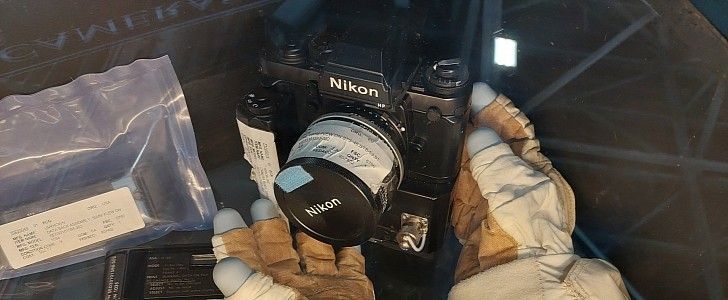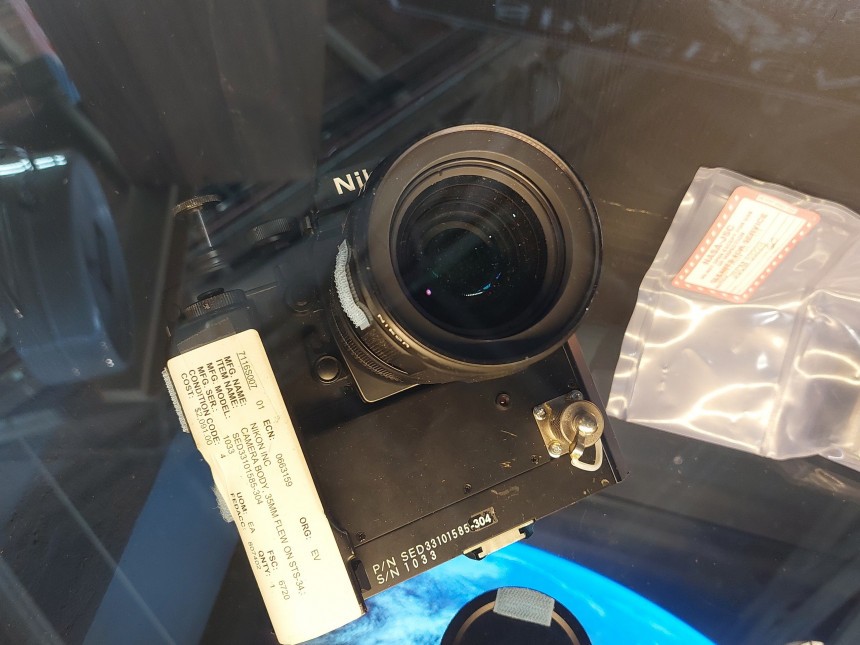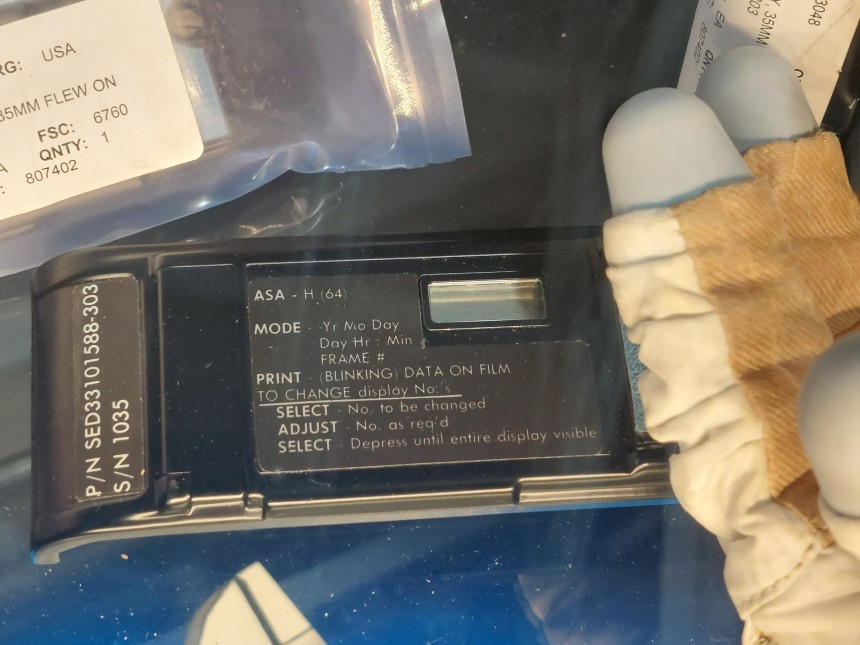It costs about $10,000 to transport one pound of material into a low geostationary orbit around the Earth. At least according to conventional wisdom.
Whether true or not, NASA can't afford the quality of the equipment mankind sends into orbit to be of shoddy quality. It's not like you can pop down to the Lunar corner camera store or the Martian supermarket and home-improvement warehouse. So when NASA choose Nikon 35mm cameras to send up into space, you know it's because they're the best built in the world.
The American Airpower Museum, as it's formally known, is located in Farmingdale, New York. On the former grounds of what was once the main production site for the iconic P-47 Thunderbold and later the A-10 Thunderbolt II. Today, the remaining hangar features exhibits that include over a dozen airworthy warbirds.
We had a blast during our visit to this museum. Check out our review if you're interested. But this exhibit of a camera with more space-time logged than most famous astronauts combined might be the best in the show. Even as a real A-10 Warthog sits guard in the flesh just outside the hangar.
Unlike the Hog and its sub-compact, car-sized cannon, this set of cameras was far less destructive. They served as reliable photo archivists of the daily lives of Space Shuttle astronauts. Everything from their experiments to their daily activities. Information on such a niche product is hard to come across, even for the dedicated staff of one of the few living warplane museums in the world, but we do know some facts for certain.
Humans, primarily American and Russian, have sent cameras into space since the late 1950s. Often heavily modified versions of cameras already in civilian service. These modifications made them easier to operate in the weightless vacuum of space. After 19 space missions, the set of two cameras and some related accessories are on display at the Airpower Museum. Needless to say, these Nikon 35mm cameras were once the gold standard of spacefaring cameras.
Cameras designed for space flight must differ from civilian models in a number of ways. Firstly, the equipment has zero shielding from the deadly radiation of ambient space, as does your flesh, for that matter. Whether from our Sun or from interstellar beams passing across the Solar System, there's more than enough radiation to go around up in space. There's also the trouble of storing the thing without it floating across the zero-gravity environment, bonking itself on a wayward switch or dial connected to something important in the process.
Searching the camera's serial number reveals an online auction listing from 2011. One for an identical "NASA" set camera. In the listing, the item is said to have sold for is a whopping figure of €16,000 ($18,106) in Vienna, Austria. For a camera that may not even function anymore, that's big money. But it doesn't get much better than this in terms of a piece of genuine scientific history.
The museum is wise to keep these sensitive relics in a sealed glass container. The grubby, sticky fingers of school-aged children in the museum could ruin the lenses if one disobeyed rules and tried to handle them. At the bottom of the case is a screen that projects a looping clip of low-earth orbit. On top of that layer of glass sits a model of the Space Shuttle. The next level of glass holds a pair of period-correct-looking EVA gloves alongside the star of the show, genuine NASA hardware.
The camera set's first mission came via STS-28 aboard Space Shuttle Columbia on August 8th, 1989. Interestingly, this mission was a Department of Defense initiative. One with a very highly classified and secretive objective, not a bad start at all. Over time, the cameras served on missions that conducted a number of different space probes launches.
The cameras also served on the STS-61 mission to service the iconic Hubble Space Telescope. The cameras hitched a ride aboard Shuttle Endeavour in 1998 for the first mission in the vehicle to the International Space Station. Its final mission came aboard Shuttle Discovery in December 1998. As lumps of expensive plastic and metal go, these cameras sure did make their money back and then some.
Thousands of photos passed through the lenses of these particularly special cameras. Some of their more pivotal missions came in service of classified military projects. So we may never see even a fraction of how many it took in space. But as quirky and informative abstract exhibits go, it's one the American Airpower Museum is no doubt very proud to have in their collection.
Check back to see more awesome exhibits from our fantastic trip to the American Airpower Museum. Right here on autoevolution.
The American Airpower Museum, as it's formally known, is located in Farmingdale, New York. On the former grounds of what was once the main production site for the iconic P-47 Thunderbold and later the A-10 Thunderbolt II. Today, the remaining hangar features exhibits that include over a dozen airworthy warbirds.
We had a blast during our visit to this museum. Check out our review if you're interested. But this exhibit of a camera with more space-time logged than most famous astronauts combined might be the best in the show. Even as a real A-10 Warthog sits guard in the flesh just outside the hangar.
Unlike the Hog and its sub-compact, car-sized cannon, this set of cameras was far less destructive. They served as reliable photo archivists of the daily lives of Space Shuttle astronauts. Everything from their experiments to their daily activities. Information on such a niche product is hard to come across, even for the dedicated staff of one of the few living warplane museums in the world, but we do know some facts for certain.
Cameras designed for space flight must differ from civilian models in a number of ways. Firstly, the equipment has zero shielding from the deadly radiation of ambient space, as does your flesh, for that matter. Whether from our Sun or from interstellar beams passing across the Solar System, there's more than enough radiation to go around up in space. There's also the trouble of storing the thing without it floating across the zero-gravity environment, bonking itself on a wayward switch or dial connected to something important in the process.
Searching the camera's serial number reveals an online auction listing from 2011. One for an identical "NASA" set camera. In the listing, the item is said to have sold for is a whopping figure of €16,000 ($18,106) in Vienna, Austria. For a camera that may not even function anymore, that's big money. But it doesn't get much better than this in terms of a piece of genuine scientific history.
The museum is wise to keep these sensitive relics in a sealed glass container. The grubby, sticky fingers of school-aged children in the museum could ruin the lenses if one disobeyed rules and tried to handle them. At the bottom of the case is a screen that projects a looping clip of low-earth orbit. On top of that layer of glass sits a model of the Space Shuttle. The next level of glass holds a pair of period-correct-looking EVA gloves alongside the star of the show, genuine NASA hardware.
The cameras also served on the STS-61 mission to service the iconic Hubble Space Telescope. The cameras hitched a ride aboard Shuttle Endeavour in 1998 for the first mission in the vehicle to the International Space Station. Its final mission came aboard Shuttle Discovery in December 1998. As lumps of expensive plastic and metal go, these cameras sure did make their money back and then some.
Thousands of photos passed through the lenses of these particularly special cameras. Some of their more pivotal missions came in service of classified military projects. So we may never see even a fraction of how many it took in space. But as quirky and informative abstract exhibits go, it's one the American Airpower Museum is no doubt very proud to have in their collection.
Check back to see more awesome exhibits from our fantastic trip to the American Airpower Museum. Right here on autoevolution.








